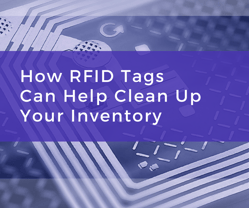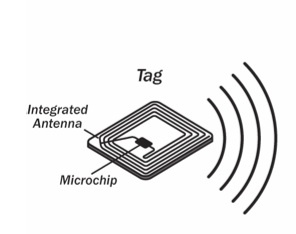 It is very likely that you encounter RFID tags everyday, even if you aren’t familiar with them. Radio-Frequency Identification tags (RFID) are small transponders attached or embedded in objects for identification. Common examples include clothing theft tags, EZ Passes, and implanted chips in pets.
It is very likely that you encounter RFID tags everyday, even if you aren’t familiar with them. Radio-Frequency Identification tags (RFID) are small transponders attached or embedded in objects for identification. Common examples include clothing theft tags, EZ Passes, and implanted chips in pets.
But this ID technology can also be used for organization and tracking beyond just everyday household use. Companies can use RFID tags to improve inventory organization and product movement efficiency. This technology is a better alternative to manually scanning barcodes, serial number systems, etc. Figure 1 below shows a typical RFID chip, with the integrated microelectronics.
 RFIDs can communicate either passively (powered by receiving radio waves) or actively (each unit has a battery) with a nearby reader, exchanging various information like location, temperature, humidity, and pressure through radio waves and EM fields. Together, the tags and readers store information in a software data bank. These tags can be used for tracking, but also maintaining an environment (like a cold storage) or monitoring the conditions in an area.
RFIDs can communicate either passively (powered by receiving radio waves) or actively (each unit has a battery) with a nearby reader, exchanging various information like location, temperature, humidity, and pressure through radio waves and EM fields. Together, the tags and readers store information in a software data bank. These tags can be used for tracking, but also maintaining an environment (like a cold storage) or monitoring the conditions in an area.
Implementation
For example, imagine the following situation:
You are the owner of a shipping company owning warehouses at the port in Newark, New Jersey. Millions of tons of capital move through your warehouses every day, being unloaded from ships, stored, and loaded onto semi trucks. Your current inventory system uses barcodes and scanners at the entrance and exit doors of each warehouse, and t he barcodes need to be in line-of-sight to be scanned. The scanners have a range of 1 meter, and must be manually triggered by personnel. The barcodes can be obstructed, covered in dirt/mud, or scratched off in transit. Now, you could continue using this system, or convert to RFIDs. With RFID tags, the entire system becomes more efficient.
Advantages of these new tags include:
As you can imagine, the implementation of the new RFID system in the above situation would greatly increase efficiency. Additonally, it allows for easier tracking and identification of products when something in a batch goes wrong, such as focusing on one pallet of products instead of ten pallets of products. Paired with the right software, diagnostics of the whole system are easier to troubleshoot than testing each tag individually.
Choosing the Right Solution
Of course, there are always downsides to new methods of communication with technology. Some expressed concerns involve the privacy of the data being transmitted, such as the ability to clone or intercept it. For this reason, some RFID systems and paired softwares have ways of encrypting the data to inhibit malicious intentions. Also, some serious analysis on the system in question needs to be considered, as RFID isn’t the best method for every inventory system.
However, if your company has a large inventory it needs to keep track of, or are interested in keeping track of a product as it moves through your production line, then RFIDs might be a solution worth looking into. RFID tags have the ability to provide feedback for IoT networks and provide a simpler and more efficient way of tracking inventory and cleaning up storage systems.
Interested in learning more about how RFID can improve your operations?


